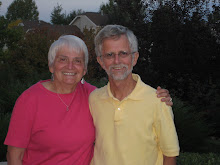Turtle Mountain
Frank Slide Intrepretive Center - In the early morning hours of April 29, 1903, Turtle Mountain in the Crowsnest Pass collapsed, resulting in the greatest landslide in North American history. In less than 100 seconds 82 million tons of massive limestone boulders slid down Turtle Mountain and covered three square kilometers of the valley under debris up to 30 meters deep. The outskirts of the town of Frank were destroyed and 90 people lost their lives. The Interpretive Center had first-hand accounts by folks who survived the slide as well as pictures of the event. Very interesting as all the Canadian Historic Sites have been.
Prairie land now with mostly grasses for grazing and wheat which has been recently harvested so bales of hay everywhere. Very scenic though gets a little tedious after awhile. Those mountains are getting closer.
Lots of wind power here on the prairie.
Then
boom, you’re in the Rockies again….no foothills here. Very dramatic change. Waterton NP started as a forest preserve in
1895. Shortly after than when Glacier
was created in 1910, Canada changed the name to Waterton Lakes Dominion Park
and later designated it a National Park. Just as we entered the Park there was a road for the Bison Paddock. There is a small herd that lives in large fenced enclosure—Prairie Bison again.
The Prince of Wales Hotel is a 7-story gabled structure was built in 1927 on the hill overlooking Upper Waterton Lake. It was financed by the railway but had no rail link and has always been US owned. Early guests were transported to the hotel by bus from the Great Northern railway in Montana.
Unfortunately, it closed for the season yesterday so no tea at the
Prince of Wales for us! Glass doors and windows do still leave the
interior visible though. Furniture already packed up though.
The view to Goats Haunt is outstanding!
Rotary International members lobbied on both
sides of the border and in 1932 it was established as the first ever
International Peace Park. In 1979 UNESCO
designated it as a Biosphere Reserve and then in 1995 a World Heritage Site. There is a nice dispslay at the waterfront.Secured a campsite after a little hunting to find a level area for the tent and then headed to the Visitor’s Center.
Then up the Akamina Parkway to Cameron Lake. This is one of three valleys in the park. It stretches from Cameron Falls, skirts a deep gorge and then climbs to the highest forest in the park and ends with Cameron Lake and it's area. Stopped for a view of the waterfall and then up to the Lake.
We wandered a little but the sun was not very good—seems it never is as the peak at the end of the lake faces west so rarely gets full sun.
There was a small pond near the lake.

where we saw a pair of white wing crossbills.
Then back down with a stop at the
Monument for Alberta’s first producing oil well. This white obelisk marks the remnants of western canada's first producing oil well: a thick cylinder of rusted steel with blocks of weathered wood still bolted to it. the well produced, but the pool dried up quickly and so did its accompanying boomtown.Then to the campground and showers and dinner with only one layer of jackets! Nice to be warm again!!


















